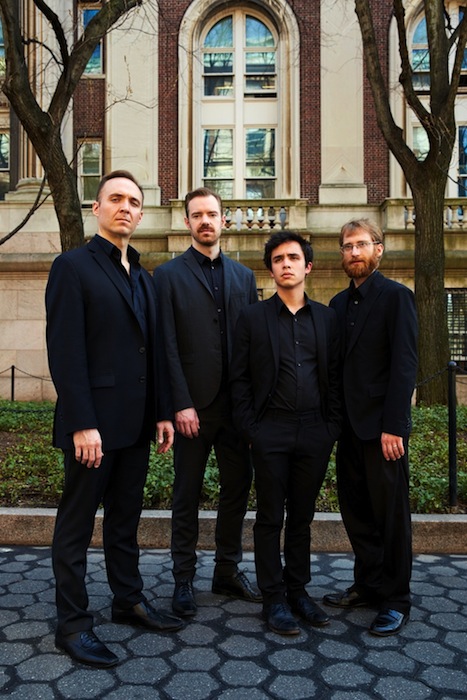JACK Quartet opens “Soundscape America” series with the modernist past and present

JACK Quartet performed the first of two programs in the “Soundscape America” series Thursday night at the Miller Theatre.
JACK Quartet has their own mini-series at Miller Theatre this week—“Soundscape America.” America is a big country, with a soundscape of music that is not only just as big but likely varied more than any other country. Is it even possible to outline such a thing across two concerts?
Of course not, but in their first concert Thursday night, JACK went surprisingly far and delivered much that was unexpected.
Not that every in attendance was pleased, or even attentive. Chalk it up to a program that was based around far more wit and irreverence than one will usually find at a classical music concert, especially one of new music.
The first sound was an open-mouthed sneeze from a audience member, timed so perfectly that it seemed to be the downbeat for Erin Gee’s Mouthpiece XXII. The sneezes continued, and so did the music, a spry mixture of harmonic glissandos, pizzicatos, whistle tones, and actual whistling. Gee usuallly works with so-called non-semantic vocal material in her Mouthpiece series, and transported to the string quartet, it made an ideal overture for JACK.
The next piece, Mark Applebaum’s Darmstadt Kindergarten, was something completely different. One is hard pressed to remember the music—there was a through-composed, energetic, dissonant line, played four times—because the piece is mostly theatrical. Better put, it’s choreographical.
After the first full statement, violinist Christopher Otto put down his instrument, came to the front of the stage, and performed a semaphor-like pantomime timed to the music. It was odd and hilarious. And the oddness and hilarity increased with each repetition, as the remaining musicians—violinist Austin Wulliman, violist John Pickford Richards, and cellist Jay Campbell—each joined in with their own variation on the pattern. Four stone-faced musicians, sending incomprehensible signals out to the audience in a kind of silent music. An old crank in the balcony complained loudly about what people are learning at music school.
One thing is how to play some of the most difficult and consequential music with command and clarity—that was JACK with Elliott Carter’s String Quartet No. 2. In the context of the concert, this piece, and Morton Feldman’s Structures for String Quartet which came in the second half, represented the foundation of the modernist avant-garde that the contemporary works built upon.
Even set against 21st-century music, Carter’s Quartet is still an exhilarating challenge—the four players are independent of one another and come together and apart in agreement and contention. It’s not possible for ears to handle the four lines simultaneously; one bounces among them, at times making a vertical stack of sound.
JACK’s playing made this almost easy. String quartets everywhere can produce the harshest and most mysterious sounds of the avant-garde, but few can also play with such refined exactitude of pitch, rhythm, and dynamics. The sonic clarity in the Carter and in Structures had the shine and delicacy of spun glass, giving what seemed to be the most honest and accurate expression of each composer’s voice.
There was something uncanny about hearing Feldman’s attacks, intonations, and rhythms articulated with such precision. Structures sits at the fine edge with traditional material used to create an avant-garde sound and concept of time. As satisfying as it was to hear exactly how the score goes, one missed the intrigue and tension that comes with hearing something that still strikes the musicians as new, unusual, and not fully understood.
JACK opened the second half with Anthony Braxton’s Composition 173. Including Braxton was an important choice in surveying the American soundscape. He is a musician with a strong influence in new music—though less so in jazz, the genre in which he is commonly identified. His body of work is so extensive, complicated, and contradictory, that anyone who claims a complete comprehension and judgment of it is bluffing.
His work frequently combines simple fundamental musical materials, graphic and symbolic notation systems, Afro-Futurism, and a personal flavor of mysticism. In this century he has increasingly been making theatrical and operatic works in which the music, and what one sees on stage itself, is just the tip of a larger, text-based aesthetic and intellectual plan.
This all works together to make his music fascinating and also impenetrable. That was the performance, adapted from what is indeed a large-scale theatrical piece. There was more dialogue than playing, and it was funny, each musician asking “What about this sound?” and playing a biting fragment.
Then it turned into a conversation with music. The music was stimulating, taught energetic conversations, like Carter but more concerted. The dialogue was impossible, sci-fi psychobabble about dimensions, angles, and strategies. That and the occasional clunky rhythms that have for decades been clichéd signifiers of the avant-garde had one thinking that Braxton is a wonderful music nerd, indulging his own curiosity with complete sincerity while not always able to communicate outside his own mind.
Last was Cenk Ergün’s Sonare, which JACK premiered and, in their previous lineup, played to open the 2016 New York Philharmonic Biennial. The piece made a strong impression then, and Thursday night reinforced the impression that this is one of the leading quartet compositions of the new century. Separated from its quiet counterpart Celare, the assured intensity of JACK’s playing had the furious perpetual motion of Sonare sounding like an mixture of heavy metal and the gripping electronic music of Alessandro Cortini. But the excellent dynamic shape and fulfilling tension and release were classical music, through and through.
JACK Quartet concludes Soundscape America with music from Gloria Coates, Ruth Crawford Seeger, Natacha Diels, Marcos Balter, and John Zorn 8 p.m. Saturday. millertheatre.com


